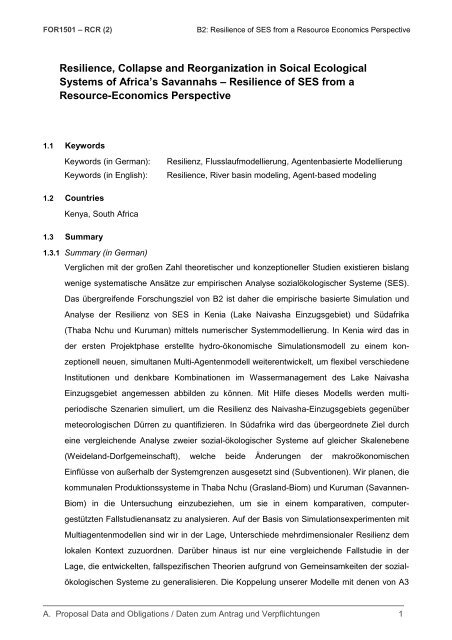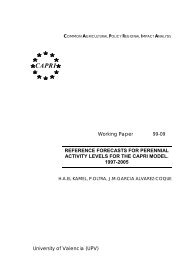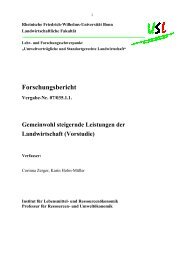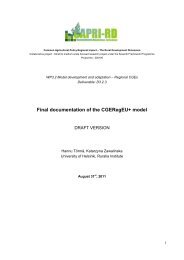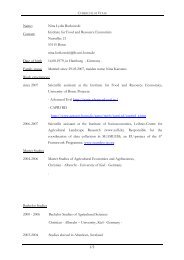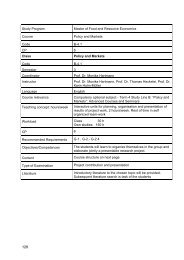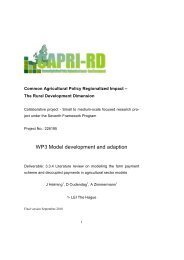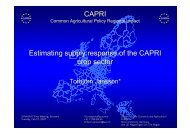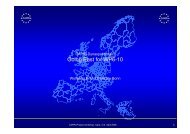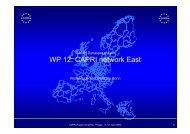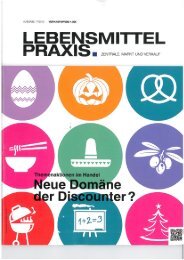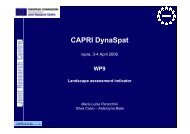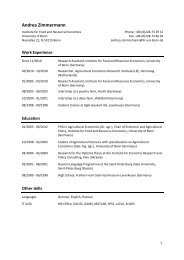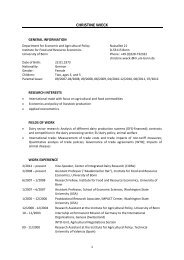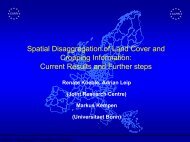Research proposal of sub-project B2 for second phase - Institut für ...
Research proposal of sub-project B2 for second phase - Institut für ...
Research proposal of sub-project B2 for second phase - Institut für ...
Create successful ePaper yourself
Turn your PDF publications into a flip-book with our unique Google optimized e-Paper software.
FOR1501 – RCR (2)<br />
<strong>B2</strong>: Resilience <strong>of</strong> SES from a Resource Economics Perspective<br />
Resilience, Collapse and Reorganization in Soical Ecological<br />
Systems <strong>of</strong> Africa’s Savannahs – Resilience <strong>of</strong> SES from a<br />
Resource-Economics Perspective<br />
1.1 Keywords<br />
Keywords (in German):<br />
Keywords (in English):<br />
Resilienz, Flusslaufmodellierung, Agentenbasierte Modellierung<br />
Resilience, River basin modeling, Agent-based modeling<br />
1.2 Countries<br />
Kenya, South Africa<br />
1.3 Summary<br />
1.3.1 Summary (in German)<br />
Verglichen mit der großen Zahl theoretischer und konzeptioneller Studien existieren bislang<br />
wenige systematische Ansätze zur empirischen Analyse sozialökologischer Systeme (SES).<br />
Das übergreifende Forschungsziel von <strong>B2</strong> ist daher die empirische basierte Simulation und<br />
Analyse der Resilienz von SES in Kenia (Lake Naivasha Einzugsgebiet) und Südafrika<br />
(Thaba Nchu und Kuruman) mittels numerischer Systemmodellierung. In Kenia wird das in<br />
der ersten Projekt<strong>phase</strong> erstellte hydro-ökonomische Simulationsmodell zu einem konzeptionell<br />
neuen, simultanen Multi-Agentenmodell weiterentwickelt, um flexibel verschiedene<br />
<strong>Institut</strong>ionen und denkbare Kombinationen im Wassermanagement des Lake Naivasha<br />
Einzugsgebiet angemessen abbilden zu können. Mit Hilfe dieses Modells werden multiperiodische<br />
Szenarien simuliert, um die Resilienz des Naivasha-Einzugsgebiets gegenüber<br />
meteorologischen Dürren zu quantifizieren. In Südafrika wird das übergeordnete Ziel durch<br />
eine vergleichende Analyse zweier sozial-ökologischer Systeme auf gleicher Skalenebene<br />
(Weideland-Dorfgemeinschaft), welche beide Änderungen der makroökonomischen<br />
Einflüsse von außerhalb der Systemgrenzen ausgesetzt sind (Subventionen). Wir planen, die<br />
kommunalen Produktionssysteme in Thaba Nchu (Grasland-Biom) und Kuruman (Savannen-<br />
Biom) in die Untersuchung einzubeziehen, um sie in einem komparativen, computergestützten<br />
Fallstudienansatz zu analysieren. Auf der Basis von Simulationsexperimenten mit<br />
Multiagentenmodellen sind wir in der Lage, Unterschiede mehrdimensionaler Resilienz dem<br />
lokalen Kontext zuzuordnen. Darüber hinaus ist nur eine vergleichende Fallstudie in der<br />
Lage, die entwickelten, fallspezifischen Theorien aufgrund von Gemeinsamkeiten der sozialökologischen<br />
Systeme zu generalisieren. Die Koppelung unserer Modelle mit denen von A3<br />
A. Proposal Data and Obligations / Daten zum Antrag und Verpflichtungen 1
FOR1501 – RCR (2)<br />
<strong>B2</strong>: Resilience <strong>of</strong> SES from a Resource Economics Perspective<br />
ist zentraler Bestandteil unserer Kooperationsstrategie. In dem hier beschriebenen<br />
Teilprojekt werden zwei Nachwuchswissenschaftler arbeiten, eine(r) zu Kenia und eine(r) zu<br />
Südafrika.<br />
1.3.2 Summary (in English)<br />
Compared to the vast number <strong>of</strong> theoretical and conceptual studies, empirical work to assess<br />
the resilience <strong>of</strong> SES still seems to be in an exploratory <strong>phase</strong>. <strong>B2</strong> addressed this problem<br />
during the first <strong>phase</strong> <strong>of</strong> the research unit (RU, FOR 1501) by developing data based<br />
numerical simulation models. The overall research objective <strong>of</strong> <strong>B2</strong> <strong>for</strong> the <strong>second</strong> <strong>phase</strong> is to<br />
empirically assess the resilience <strong>of</strong> SES in Kenya (Lake Naivasha Basin) and South Africa<br />
(communal livestock systems in Thaba Nchu and Kuruman) using these further developed<br />
and integrated numerical simulation models. In Kenya, the hydro-economic basin model will<br />
be developed into a conceptually innovative simultaneous multi-agent model to simulate<br />
institutional deficiencies in the water management <strong>of</strong> the Lake Naivasha basin. Multi-period<br />
simulations will be carried out <strong>for</strong> different institutional settings <strong>for</strong> water management with<br />
the purpose <strong>of</strong> quantifying the resilience <strong>of</strong> the Lake Naivasha Basin SES towards<br />
meteorological shocks such as multi-annual droughts. For South Africa, the same<br />
overarching objective is pursued by conducting a comparative analysis <strong>of</strong> two SES on the<br />
same scale (community-rangeland SES), <strong>sub</strong>ject to identical macro-economic disturbances<br />
from outside the system boundaries (change in <strong>sub</strong>sidization). Communal production<br />
systems in Thaba Nchu (grassland biome) and Kuruman (savannah biome) will be<br />
investigated in a comparative, computational case study approach. By means <strong>of</strong> simulation<br />
experiments with multi-agent systems, differences in multi-scale SES resilience will be<br />
related to specifics <strong>of</strong> the local context. Moreover, the comparative approach allows <strong>for</strong><br />
partial extensions <strong>of</strong> theories, which are thus far only case specific, because <strong>of</strong> the<br />
similarities <strong>of</strong> the two SES being studied. The coupling <strong>of</strong> these models with those <strong>of</strong> A3 is<br />
central to collaboration ef<strong>for</strong>ts. Two junior researchers will work in this <strong>project</strong>, one in Kenya<br />
and on in South Africa.<br />
A. Proposal Data and Obligations / Daten zum Antrag und Verpflichtungen 2
FOR1501 – RCR (2)<br />
<strong>B2</strong>: Resilience <strong>of</strong> SES from a Resource Economics Perspective<br />
2. PARTICIPATING INDIVIDUALS / ANGABEN ZU DEN BETEILIGTEN PERSONEN<br />
2.1 Applicants<br />
INFO<br />
Main Applicant<br />
Academic degree/title:<br />
Pr<strong>of</strong>. Dr.<br />
First name:<br />
Thomas<br />
Last name:<br />
Heckelei<br />
Nationality:<br />
German<br />
Gender: male / female<br />
Date <strong>of</strong> birth: 18.11.1963<br />
German-speaking: yes / no<br />
E-mail address:<br />
thomas.heckelei@ilr.uni-bonn.de<br />
Telephone: +49-228-732331<br />
Address <strong>of</strong> the institution that will<br />
host the proposed <strong>project</strong>:<br />
<strong>Institut</strong>e <strong>for</strong> Food and Resource Economics (ILR),) University<br />
<strong>of</strong> Bonn, Nussallee 21, 53115 Bonn<br />
2.2 Other participating individuals<br />
Please provide the following in<strong>for</strong>mation <strong>for</strong> each participating individual.<br />
INFO Participant 1 Participant 2<br />
Academic degree/title: Dr.<br />
First name: Arnim Sebastian<br />
Last name: Kuhn Rasch<br />
Nationality: German German<br />
Gender: male / female male / female<br />
Date <strong>of</strong> birth: 31.01.1967 15.09.1978<br />
German-speaking: yes / no yes / no<br />
E-mail address: arnim.kuhn@ilr.uni-bonn.de sebastian.rasch@ilr.uni-bonn.de<br />
Telephone: +49 228-73-2843 +49 228-73-2335<br />
Address:<br />
ILR, University <strong>of</strong> Bonn, Nussallee<br />
21, 53115 Bonn<br />
ILR, University <strong>of</strong> Bonn, Nussallee<br />
21, 53115 Bonn<br />
[Comments on participating individuals: Dr. Arnim Kuhn worked as post-doc in <strong>phase</strong> I <strong>of</strong> the RU.<br />
He is an expert in river basin modeling and will support the proposed research <strong>of</strong> <strong>B2</strong> in Naivasha,<br />
Kenya during <strong>phase</strong> II. Sebastian Rasch also worked as a doctoral researcher in <strong>phase</strong> I and will<br />
finish his PhD in 2013. He is an expert in agent-based modeling and will support the research <strong>of</strong><br />
<strong>B2</strong> in South Africa during <strong>phase</strong> II.]<br />
A. Proposal Data and Obligations / Daten zum Antrag und Verpflichtungen 3
FOR1501 – RCR (2)<br />
<strong>B2</strong>: Resilience <strong>of</strong> SES from a Resource Economics Perspective<br />
3. PARTICIPATING INSTITUTIONS / BETEILIGTE INSTITUTE<br />
<strong>Institut</strong>e <strong>for</strong> Food and Resource Economics (ILR), University <strong>of</strong> Bonn, Department <strong>for</strong> Agricultural<br />
and Economic Policy, Nussallee 21, 53115 Bonn, Germany<br />
A. Proposal Data and Obligations / Daten zum Antrag und Verpflichtungen 4
FOR1501 – RCR (2)<br />
<strong>B2</strong>: Resilience <strong>of</strong> SES from a Resource Economics Perspective<br />
A. Project Description / Beschreibung des Vorhabens<br />
Pr<strong>of</strong>. Dr. Thomas Heckelei, University <strong>of</strong> Bonn<br />
[DFG <strong>for</strong>m 54.012 – 1/12]<br />
I. PROJECT DESCRIPTION / BESCHREIBUNG DES VORHABENS<br />
1. STATE OF THE ART, WORK IN PHASE I / STAND DER FORSCHUNG, ARBEIT IN<br />
PHASE I<br />
1.1 State <strong>of</strong> the Art<br />
The overall objective <strong>of</strong> <strong>B2</strong> <strong>for</strong> <strong>phase</strong> II is to assess the resilience <strong>of</strong> SES in Kenya and South<br />
Africa using numerical simulation models that are innovatively specified to make the best use<br />
<strong>of</strong> collected data. Compared to the vast number <strong>of</strong> theoretical and conceptual studies,<br />
empirical research assessing the resilience <strong>of</strong> SES is still in an exploratory <strong>phase</strong>. Apart from<br />
the challenge <strong>of</strong> defining ‘resilience <strong>of</strong> an SES’, practical problems arise from the fact that<br />
regime shifts in SES are observed with low frequency, while experiments aimed at pushing<br />
SES towards critical thresholds are impossible <strong>for</strong> ethical reasons (Carpenter et al. 2005).<br />
One <strong>of</strong> the first attempts to assess the resilience <strong>of</strong> SES based on qualitative case studies is<br />
made by Berkes and Seixas (2005), who look <strong>for</strong> factors influencing resilience <strong>of</strong> five lagoon<br />
fisheries on different continents. They identify the role <strong>of</strong> social learning, organizational and<br />
knowledge diversity, and opportunities <strong>for</strong> self-organization as important clusters <strong>of</strong> factors<br />
<strong>for</strong> building resilience <strong>of</strong> SES. On the other hand, breakdown <strong>of</strong> resource institutions, rapid<br />
technological and socio-economic change, and institutional instability across political scales<br />
have the potential to weaken resilience. In another case study, Marschke and Berkes (2006)<br />
investigate the livelihood resilience <strong>of</strong> Cambodian fishing communities using a mix <strong>of</strong><br />
qualitative and quantitative methods. They point out the importance <strong>of</strong> poverty traps, thereby<br />
questioning the positive connotation <strong>of</strong> resilience, and consequently suggest well-being as a<br />
‘culturally appropriate surrogate’ <strong>for</strong> positive resilience.<br />
Sallu et al. (2010) assess the vulnerability and resilience <strong>of</strong> livelihoods in drylands <strong>of</strong> rural<br />
Botswana in a multi-disciplinary study spanning an investigation period <strong>of</strong> three decades.<br />
They develop ‘resilience narratives’ based on the analysis <strong>of</strong> livelihood trajectories and<br />
illustrate the combined influence <strong>of</strong> environmental variation and institutions in determining a<br />
household’s access to assets and, consequently, its ability to generate more resilient<br />
livelihood outcomes. A number <strong>of</strong> other studies take a historical perspective to work out<br />
resilience narratives, as <strong>for</strong> instance Newton (2011), who gives an account <strong>of</strong> a 900-year old<br />
<strong>for</strong>est reserve in England. The impact <strong>of</strong> fundamental changes <strong>of</strong> Chinese economic policy<br />
regimes on the degree <strong>of</strong> coupling and resilience <strong>of</strong> pastoral SES in Inner Mongolia is<br />
discussed (Li & Li 2012), and <strong>for</strong> agro-<strong>for</strong>estry communities in Sichuan (Urgenson et al.<br />
2010). A more structural approach <strong>of</strong> providing empirical resilience assessments is based on<br />
the concept <strong>of</strong> the adaptive cycle (Gunderson and Holling 2002). A comparative study <strong>of</strong> five<br />
national Pacific salmon fisheries (Augerot and Smith 2010) attempts to determine the current<br />
status <strong>of</strong> each individual fishery within the cycle, while a long-term study <strong>of</strong> a single Sahelian<br />
village since the severe drought <strong>of</strong> the early 70’s monitors the movement <strong>of</strong> the agro-pastoral<br />
SES through the adaptive cycle.<br />
Examples <strong>of</strong> numerical models explicitly simulating the resilience <strong>of</strong> SES are still rare. A<br />
generic model is proposed by Fletcher and Hilbert (2007) which measures resilience as the<br />
“size <strong>of</strong> the basin <strong>of</strong> attraction near a desirable equilibrium and the return time following small<br />
A. Proposal Data and Obligations / Daten zum Antrag und Verpflichtungen 5
FOR1501 – RCR (2)<br />
<strong>B2</strong>: Resilience <strong>of</strong> SES from a Resource Economics Perspective<br />
perturbations”. Keeping long-term sustainable production constant across different<br />
management scenarios, they identify a strong trade-<strong>of</strong>f between pr<strong>of</strong>itability and resilience.<br />
Another generic model is applied by Anderies and Hegmon (2011) to simulate development<br />
trajectories <strong>of</strong> prehistoric societies <strong>of</strong> the US South-West. Schlüter and Pahl-Wostl (2007)<br />
use an empirical agent-based hydro-economic model to compare mechanisms <strong>of</strong> resilience<br />
in the semiarid Amudarya river basin in Central Asia. The agent-based structure <strong>of</strong> applied<br />
simulation models allows these authors to quantify the impact <strong>of</strong> more or less centralized<br />
institutional settings on the resilience <strong>of</strong> water-based SES at different scales. The change<br />
and dynamics <strong>of</strong> monetary returns from water use are used as surrogates <strong>for</strong> the resilience<br />
<strong>of</strong> the agro-economic <strong>sub</strong>system <strong>of</strong> the SES.<br />
In a review article, Schlüter et al. (2012) claim that numerous recent simulation models are<br />
part <strong>of</strong> an emerging field that one may call SES modeling. SES models have been applied to<br />
fisheries, wildlife and rangeland systems, and are borrowing from complex system theory<br />
and resilience thinking. SES modeling differs from traditional disciplinary modeling<br />
approaches by explicitly taking the coupling <strong>of</strong> the ecosystem with the social system into<br />
account, and by acknowledging the complexity <strong>of</strong> the human-nature coupled system.<br />
Traditional ecosystem models treat the social realm as exogenous, whereas bio-economic<br />
models consider resource users. In bio-economic models, rational actors maximize utility<br />
<strong>sub</strong>ject to resource constraints (figure 1). However, in bio-economic models "[...] diverse<br />
actors <strong>of</strong> the social system are not considered and resource dynamics are generally very<br />
simple." (Schlüter et al. 2012). In contrast, SES models account <strong>for</strong> both heterogeneous<br />
decision making and rich ecological dynamics. This implies that the field <strong>of</strong> SES modeling is<br />
necessarily <strong>of</strong> a multidisciplinary nature. Schlüter et al. (2012) underpin the need <strong>for</strong> coupling<br />
institutional, ecological and economic models as “slowly evolving institutional rules and<br />
infrastructure systems interact with faster resource dynamics and even faster economic<br />
decisions.”.<br />
Especially <strong>for</strong> resilience assessments, the modeling <strong>of</strong> resource management institutions,<br />
along with ecological and economic processes, should be a part <strong>of</strong> every SES model.<br />
However, the field is still in its infancy ass SES models <strong>of</strong>ten lack a strong empirical basis<br />
and are rarely context specific with respect to the SES in question. According to Schlüter et<br />
al. (2012), the emerging field <strong>of</strong> SES modeling must tackle this problem in order to provide<br />
useful guidance <strong>for</strong> sustainable management (Schlüter et al. 2012:256).<br />
1.2 Experience from Phase I and previous work<br />
1.2.1 <strong>Research</strong> goals <strong>of</strong> <strong>B2</strong> during <strong>phase</strong> I <strong>of</strong> the RU FOR1501<br />
<strong>Research</strong> by <strong>B2</strong> was conducted at two sites:: the Lake Naivasha Basin in Kenya, and the<br />
communal livestock systems <strong>of</strong> Thaba Nchu, South Africa; the methodological metaframework<br />
used was identical <strong>for</strong> both research sites. The overall goal <strong>of</strong> <strong>project</strong> <strong>B2</strong> was to<br />
strengthen the link between natural and social sciences by modeling the interaction between<br />
ecosystems, the resources that these ecosystems incorporate, and the human communities<br />
using and managing these resources in the described SES. The main analytical tools applied<br />
were bio-economic numerical simulation and empirical analysis <strong>of</strong> the <strong>for</strong>mal and in<strong>for</strong>mal<br />
institutional designs that are relevant <strong>for</strong> the regulation <strong>of</strong> resource use in the study sites.<br />
1.2.2 <strong>Research</strong> activities <strong>of</strong> <strong>B2</strong> during <strong>phase</strong> I<br />
Hydro-economic modeling (Kenya): The <strong>project</strong> started with the design <strong>of</strong> a stylized hydroeconomic<br />
model based on mathematical programming which is able to reflect the absence <strong>of</strong><br />
A. Proposal Data and Obligations / Daten zum Antrag und Verpflichtungen 6
FOR1501 – RCR (2)<br />
<strong>B2</strong>: Resilience <strong>of</strong> SES from a Resource Economics Perspective<br />
institutional regulations as the reference situation against which all institutional re<strong>for</strong>ms and<br />
innovations can be contrasted. Conventional hydro-economic river basin models are still<br />
basically designed as planning models. They use an optimization criterion aggregated across<br />
all locations or agents (e.g. basin-wide economic welfare <strong>of</strong> water users), which is an<br />
approach that inherently carries strong institutional assumptions. Specifically, the results <strong>of</strong><br />
these conventional models imply that water allocation between locations is either a result <strong>of</strong><br />
welfare-maximizing central planning or, equivalently, perfectly functioning markets <strong>for</strong> water<br />
use rights (Kuhn and Britz 2012). In reality, however, water use in the river basins <strong>of</strong><br />
developing countries is <strong>of</strong>ten only weakly managed through water institutions, if at all. The<br />
Lake Naivasha Basin is a case in point, as water use permits and water pricing are mainly<br />
imposed on large, commercial users in the riparian zone <strong>of</strong> Lake Naivasha, while the growing<br />
use <strong>of</strong> irrigation water by smallholders in the upper catchment <strong>of</strong> the basin is hardly regulated<br />
at all. The simulation <strong>of</strong> this situation <strong>of</strong> deficient institutional development is difficult to<br />
achieve with models that inherently assume central planning or water markets. This new<br />
model approach, as discussed in Kuhn and Britz (2012), avoids such assumptions by<br />
trans<strong>for</strong>ming the non-linear optimization problem (NLP) - where local water shadow prices<br />
are not explicitly addressed - into a mixed-complementarity problem (MCP). This stylized<br />
model provides the blueprint <strong>for</strong> the empirical model developed in this <strong>project</strong> <strong>for</strong> the<br />
Naivasha Basin. Two conference oral presentations and two research papers, one accepted<br />
<strong>for</strong> publication (Kuhn and Britz 2012), and one in the <strong>second</strong> round <strong>of</strong> review (Britz, Kuhn and<br />
Ferris 2012) are the result <strong>of</strong> this conceptual ef<strong>for</strong>t.<br />
During the development <strong>of</strong> the conceptual model, data collection <strong>for</strong> the empirical model was<br />
initiated. The numerical model <strong>for</strong> the Lake Naivasha Basin (Lake Naivasha Hydro-Economic<br />
Basin Model, LANA-HEBAMO) requires data from hydrology, agronomy, economics and<br />
demography. Most data are taken from <strong>of</strong>ficial statistics or previous studies. For the latter<br />
data source, and <strong>for</strong> empirical modeling in general, very fruitful cooperation has emerged<br />
between this <strong>project</strong> and the Faculty <strong>of</strong> Geo-In<strong>for</strong>mation Science and Earth Observation <strong>of</strong><br />
the University <strong>of</strong> Twente (ITC, Netherlands). ITC has been intensively involved in empirical<br />
research in the Lake Naivasha area <strong>for</strong> almost two decades, predominantly covering<br />
hydrological topics, but also agronomy and socio-economic issues. In the course <strong>of</strong> this<br />
research, ITC has accumulated a comprehensive database <strong>for</strong> the Lake Naivasha<br />
catchment. Moreover, ITC facilitated collaboration between this <strong>project</strong> and other research<br />
groups from the UK and Canada currently working in the Naivasha area. In order to exploit<br />
synergy effects in data collection, exchange and modeling between these groups, the<br />
agronomic and economic <strong>project</strong>s <strong>of</strong> this RU (FOR 1501) have <strong>for</strong>med an in<strong>for</strong>mal research<br />
consortium regular meetings in the Netherlands or Bonn. The consortium also established its<br />
own internal website (https://sites.google.com/site/naivasharesearch 1 ). Thanks to the<br />
cooperation with ITC, data could be supplied <strong>for</strong> the LANA-HEBAMO model:: a multiregional,<br />
recursive-dynamic model which is able to simulate local, physically interdependent water<br />
availabilities in the Lake Naivasha Basin <strong>for</strong> a broad variety <strong>of</strong> hydrological, economic or<br />
demographic scenarios. The current version is able to reflect surface and lake water flows<br />
and use, whereas groundwater is in the process <strong>of</strong> being included in order to make use <strong>of</strong><br />
new ITC groundwater data currently being collected in the region. Data on the dynamic crop<br />
water use patterns in the catchment <strong>of</strong> Lake Naivasha werewere collected during the<br />
agricultural water user survey (see below) and are currently being transferred to the<br />
numerical model. Moreover, LANA-HEBAMO will be trans<strong>for</strong>med so that it resembles a<br />
1 For guest access please contact Pieter van Oel (Oel@itc.nl).<br />
A. Proposal Data and Obligations / Daten zum Antrag und Verpflichtungen 7
FOR1501 – RCR (2)<br />
<strong>B2</strong>: Resilience <strong>of</strong> SES from a Resource Economics Perspective<br />
model <strong>of</strong> multiple interacting agents with different objectives similar to the stylized river basin<br />
model discussed at the beginning <strong>of</strong> this section.<br />
Bio-economic modeling (South Africa): For the South African case, the bio-economic<br />
simulation model has two long-term goals: (i) to quantify the resilience <strong>of</strong> SES <strong>sub</strong>ject to<br />
disturbance regimes, and (ii) to encompass endogenously evolving institutional<br />
arrangements on the basis <strong>of</strong> trust and normative traits. In this way, modelers are able to<br />
investigate overall impact on ES by deliberately analyzing measures to build adaptive<br />
capacity in the system, i.e. the ability to manage resilience.<br />
The social <strong>sub</strong>-system including herd dynamics is modeled by an agent based modeling<br />
approach (ABM). ABMs constitute a <strong>for</strong>m <strong>of</strong> generative social science and are able to<br />
produce macro-phenomena which are emergent properties <strong>of</strong> the micro-specification. In<br />
combination with ecological modeling, ABMs are able to generate social-ecological emergent<br />
phenomena, such as resilience. The potential <strong>for</strong> emergence is a feature <strong>of</strong> complex<br />
adaptive systems (CAS), among which SES are counted. ABMs are able to mimic CAS in<br />
that they generate emergence on the system level. Moreover, the ability to implement<br />
boundedly rational behavior <strong>of</strong> interacting heterogeneous actors is exclusive to this modeling<br />
approach. ABMs have proven to be a suitable approach <strong>for</strong> modeling trust and normative<br />
behavior. The social simulation has been combined with a system-dynamics biomass growth<br />
model representing rangeland productivity. Productivity and degradation in this <strong>sub</strong>-model<br />
depend on soil characteristics, species composition and is influenced by climate and grazing<br />
pressure. The ecological <strong>sub</strong>-model was developed by <strong>project</strong> A3 and is in<strong>for</strong>med by the soil<br />
science <strong>sub</strong>groups. To summarize, the coupled ABM-System dynamics model constitutes<br />
the bridging capital <strong>for</strong> the South Africa research teams, as soil science, grassland science,<br />
anthropology, history and economics are contributing empirical evidence and functional<br />
relations in a multidisciplinary manner.<br />
<strong>Institut</strong>ional economics analysis (Kenya): In August and September 2010, consultations were<br />
held with important stakeholders in the Lake Naivasha basin, including the Water Resources<br />
Management Authority (WRMA), Water Resources Users Associations (WRUAs),<br />
Commercial Horticultural Farms (represented by Lake Naivasha Growers Group, LNGG),<br />
and Non Governmental Organizations (WWF and CARE, Kenya). Based on the results <strong>of</strong> the<br />
consultations, a large survey was conducted among 308 randomly sampled landowners and<br />
water users in eight out <strong>of</strong> the twelve WRUAS in the Lake Naivasha Basin between April and<br />
August 2011. The visited WRUAs are all located in the upper catchment <strong>of</strong> the lake, which<br />
means that their water use patterns have an increasing impact on Lake Naivasha’s<br />
hydrology, ecology and economy. Data cleaning was conducted between September and<br />
December 2011. Publications prepared cover the following topics:<br />
• In a paper published as a discussion paper (Kyalo-Willy, Kuhn and Holm-Müller 2012), the<br />
‘payments <strong>for</strong> environmental services’ system (PES) was discussed which emerged in the<br />
Naivasha basin between different user groups in an institutional setting characterized by a<br />
weak government and almost no implementation <strong>of</strong> <strong>for</strong>mal regulations.<br />
• A paper currently undergoing revision <strong>for</strong> re-<strong>sub</strong>mission to the Ecological Economics<br />
journal explores how social influence and collective action institutions affect the intensity<br />
<strong>of</strong> investment in soil conservation practices as a driver <strong>of</strong> adaptive capacity in the Lake<br />
Naivasha basin social-ecological system (Kyalo-Willy and Holm-Müller 2012).<br />
• In a recently completed master thesis, the opportunity costs and effects <strong>of</strong> selected on<br />
crop productivity at household level were explored (Zhunusova 2012).<br />
A. Proposal Data and Obligations / Daten zum Antrag und Verpflichtungen 8
FOR1501 – RCR (2)<br />
<strong>B2</strong>: Resilience <strong>of</strong> SES from a Resource Economics Perspective<br />
• In addition to the research activities outlined in the <strong>proposal</strong>, a survey on the drought<br />
vulnerability <strong>of</strong> resource-based livelihoods was carried by a Diploma student (Molitor<br />
2011).<br />
<strong>Institut</strong>ional economics analysis (South Africa): During a preliminary visit in September 2010,<br />
a variety <strong>of</strong> stakeholders were consulted. Specifically, representatives from farmer<br />
organizations (Free State Agriculture), government agencies (Ministry <strong>of</strong> agriculture and<br />
fisheries, SALGA), and scientific experts (University <strong>of</strong> the Free State) were approached.<br />
Moreover, in<strong>for</strong>mal visits to production systems under different tenure systems were held.<br />
The insights gained from the preliminary visit shaped the further research approach.<br />
Specifically, the most complex interactions were indentified in ‘communal areas’, where small<br />
scale cattle producers are challenged by issues <strong>of</strong> collective action in the absence <strong>of</strong><br />
individual property rights. Several interviews were conducted with local leaders in order to<br />
assess general structures within communities.<br />
The findings from those preliminary investigations were used to design a household survey<br />
based on the World Bank’s living standard and measurement (LSMS) survey scheme. This<br />
survey was adapted to the local specificities and expanded to cover institutional variables<br />
such as mutual trust or joint resource management practices. The survey was administered<br />
to the whole livestock producing population (80), as well as to a <strong>sub</strong>set <strong>of</strong> non-livestock<br />
owners (30) in the community <strong>of</strong> Sediba (Thaba Nchu) from September to December 2011.<br />
The time <strong>of</strong> survey work corresponded with the anthropologic field work <strong>of</strong> <strong>project</strong> A1, which<br />
directed and framed the objectives <strong>of</strong> semi-<strong>for</strong>mal interview questions in <strong>B2</strong>. Moreover, an<br />
additional 300 questionnaires were administered to households in three other villages in the<br />
Thaba Nchu region from May to July 2012. Survey results have been analyzed and are in<br />
preparation <strong>for</strong> a publication in cooperation with A1. Key objectives <strong>of</strong> this work are to:<br />
• Delineate the historical context <strong>of</strong> common pool resource SESs in the region and derive<br />
consequences <strong>for</strong> the current system regimes;<br />
• Characterize the economic situation <strong>of</strong> livestock producers on the household level in light<br />
<strong>of</strong> agricultural income as a contribution to total household income;<br />
• Derive mental models <strong>of</strong> decision makers as a necessary element to in<strong>for</strong>m a simulation<br />
model with behavioral strategies <strong>of</strong> heterogeneous, interacting social agents.<br />
Moreover, a diploma thesis is in preparation with the aim <strong>of</strong> investigating the adaptive<br />
capacity <strong>of</strong> livestock producers in the communal production systems <strong>of</strong> Thaba Nchu. Focus<br />
groups and in-depth qualitative interviews are planned to elucidate stakeholder changes with<br />
respect to appropriation ef<strong>for</strong>ts in reaction to climatic and economic disturbances. The aim is<br />
to deduct pathways <strong>of</strong> further research in order to improve the representation <strong>of</strong> learning<br />
capabilities in the simulation model.<br />
1.2.3 Results <strong>of</strong> <strong>B2</strong> in <strong>phase</strong> I<br />
Hydro-economic modeling (Kenya): Results regarding this activity originate from conceptual<br />
modeling (Kuhn and Britz 2012) and preliminary versions <strong>of</strong> the empirical model (Kuhn et al.<br />
2012). The conceptual model studies revealed that:<br />
• Conventional river basin models carry inherent institutional assumptions which bias the<br />
results <strong>of</strong> both the models’ baseline and counterfactual scenarios. Specifically, they<br />
assume a-priori that water use is centrally managed by planning or markets in order to<br />
maximize an aggregate welfare criterion.<br />
A. Proposal Data and Obligations / Daten zum Antrag und Verpflichtungen 9
FOR1501 – RCR (2)<br />
<strong>B2</strong>: Resilience <strong>of</strong> SES from a Resource Economics Perspective<br />
• The most important problem <strong>of</strong> unregulated water use in river basins is that water users<br />
with privileged access due to their upstream location have no incentive to save water.<br />
Their willingness to pay <strong>for</strong> water is zero as long as their production capacities do not<br />
require all available water.<br />
• This means that upstream users may use water more inefficiently than downstream users,<br />
the latter which will be more constrained in their water use than under central planning or<br />
perfectly functioning markets <strong>for</strong> water rights.<br />
• Conventional river basin models cannot reflect this due to their algebraic problem <strong>for</strong>mat.<br />
The stylized river basin model developed in this <strong>project</strong> is able to overcome this problem.<br />
In a nutshell, the proposed model is able to simulate realistic local water shadow prices.<br />
• Applied to the Naivasha catchment, these insights allow <strong>for</strong> the analysis <strong>of</strong> future conflicts<br />
over water <strong>for</strong> irrigation in a more realistic way. In the upper catchment <strong>of</strong> the basin, water<br />
use <strong>for</strong> irrigation by small-scale farmers, but also by larger commercial outfits, is<br />
increasing rapidly. Small-scale water use in particular is not regulated, while large users<br />
are obliged to obtain volumetric permits and pay <strong>for</strong> water.<br />
• First simulations with the empirical simulation model suggest that the marginal returns to<br />
small-scale water use practices are likely to be small in comparison to the horticultural<br />
industry in the downstream area <strong>of</strong> the basin. Water pricing schemes oriented to local<br />
marginal returns <strong>for</strong> water would have much smaller structural effects as compared to<br />
uni<strong>for</strong>m water prices across the basin.<br />
Bio-economic modeling (South Africa): Insights gained from the conceptual modeling task <strong>of</strong><br />
communal production systems in Thaba Nchu (grassland biome) are as follows:<br />
• The emerging field <strong>of</strong> socio-ecological modeling faces two major limitations: (i) SES<br />
models lack a common conceptual framework <strong>for</strong> e.g. measuring resilience, and (ii) they<br />
should be more specific to the empirical reality <strong>of</strong> case studies Schlüter et al. 2012::258).<br />
• The first problem is addressed by devising a conceptual framework <strong>of</strong> linked resilience<br />
scales <strong>of</strong> SES with the aim <strong>of</strong> deducting simple and straight<strong>for</strong>ward measures <strong>of</strong><br />
resilience.<br />
• Resiliencies are measured at the ecological, household, social, socio-ecological and<br />
general system identity level. All scales are endogenously linked by dynamic processes in<br />
the model.<br />
• Socio-ecological and general systems resilience is understood as emergent properties <strong>of</strong><br />
complex systems. Thus, the agreed upon tool <strong>for</strong> representing complex adaptive systems<br />
(CAS) was applied: agent based modeling (ABM).<br />
• In order to address the <strong>second</strong> shortcoming <strong>of</strong> SES models, model mechanisms are<br />
based on empirical insights from the case study.<br />
• Specifically, human decision making with respect to resource use was identified by<br />
explorative statistical analysis and econometric modeling, as well as by qualitative data<br />
from field studies.<br />
• First simulation results suggest a stable to decreasing stocking rate and a further<br />
concentration <strong>of</strong> households who own cattle in the next 50 years.<br />
• This implies decreasing pressure on the ecological system with a parallel increase <strong>of</strong><br />
social inequality. Thus, the SES is faced with losing its identity <strong>of</strong> being a communal<br />
production system, while gaining advantages in terms <strong>of</strong> its ecological resilience.<br />
A. Proposal Data and Obligations / Daten zum Antrag und Verpflichtungen 10
FOR1501 – RCR (2)<br />
<strong>B2</strong>: Resilience <strong>of</strong> SES from a Resource Economics Perspective<br />
• There is no single resilience measurement <strong>for</strong> any given SES. Resilience depends on the<br />
scale <strong>of</strong> measurement.<br />
<strong>Institut</strong>ional economics analysis (Kenya): The following results have emerged from the work<br />
done on understanding the challenges that agro-environmental institutions are facing, hence<br />
limiting their capacity to enhance SES resilience:<br />
• Formal institutions are weak, based on the observation, <strong>for</strong> instance, that very few actors<br />
have a legal permit <strong>for</strong> their water abstraction activities.<br />
• The newly created WRUAs are not yet operational: they are top-down institutions lacking<br />
self-organizations <strong>of</strong> users, but their functioning might assist in basin-wide management.<br />
• Volatilities in water levels, siltation, eutrophication and water over-abstraction leading to<br />
scarcity were identified as the key environmental challenges driven by both anthropogenic<br />
influences and natural conditions.<br />
• In principle, interactions among farms at the lake and farmers at the upper catchments<br />
could enhance the robustness <strong>of</strong> this specific SES by making use <strong>of</strong> Payments <strong>for</strong><br />
Environmental Services (PES). A first PES pilot <strong>project</strong> is in place, but the payment<br />
amounts are very small.<br />
<strong>Institut</strong>ional economics analysis (South Africa): Findings from the surveys on living standards<br />
investigations <strong>of</strong> the institutional settings governing resource use in communal production<br />
systems <strong>of</strong> rural Thaba Nchu are outlined, which are followed by a discussion on their<br />
implications <strong>for</strong> resilience.<br />
<strong>Institut</strong>ional collapse: External interventions under Apartheid in the <strong>for</strong>m <strong>of</strong> resettlements to<br />
and within the Bophuthatswana homeland led to an erosion <strong>of</strong> social networks and social<br />
embeddedness. During Apartheid, top-down agricultural management schemes hampered<br />
the accumulation <strong>of</strong> social capital and crowded out the intrinsic motivation <strong>of</strong> stakeholders.<br />
The sudden halt <strong>of</strong> all agricultural services after the fall <strong>of</strong> Apartheid <strong>sub</strong>tracted all external<br />
capital from the system and led to an institutional collapse <strong>of</strong> the SES. Interview results<br />
indicate that decisions making only takes place on an individual level and is based on<br />
heuristics.<br />
Moderate overstocking: AA relative similarity <strong>of</strong> herd sizes was observed, which can be<br />
attributed to high levels <strong>of</strong> normative sanctioning. Structural inertia regarding herd size within<br />
the village is also reflected by low aspiration levels <strong>of</strong> respondents with respect to desired<br />
herd sizes. Overall, the rangeland faces long-term degradation which is, however, not due to<br />
overstocking in terms <strong>of</strong> exceeding recommended animal numbers, but rather a result <strong>of</strong> the<br />
absence <strong>of</strong> joint herd management ef<strong>for</strong>ts (no fencing, no rotational grazing).<br />
Decoupling <strong>of</strong> the livestock SES: Most households depend, to a large extent, on<br />
governmental transfers and remittances from migrant workers. Overall, the limited resource<br />
size in conjunction with age-based governmental transfers, normative sanctioning, and<br />
migration <strong>of</strong> workers fostered a process <strong>of</strong> de-agrarization. This is also a result <strong>of</strong> the<br />
relatively low pr<strong>of</strong>itability <strong>of</strong>, and thus low economic dependence on, livestock production as<br />
a means <strong>for</strong> income generation. Thus, the SES is in an ongoing process <strong>of</strong> decoupling with<br />
respect to the ecological and socio-economic dimensions.<br />
Implication <strong>for</strong> resilience: Resilience cannot be measured on a single scale in isolation.<br />
Instead, linked scales <strong>of</strong> resilience on the household, social, ecological and general system<br />
level must be taken into account. Livelihoods <strong>of</strong> individual households in communal<br />
A. Proposal Data and Obligations / Daten zum Antrag und Verpflichtungen 11
FOR1501 – RCR (2)<br />
<strong>B2</strong>: Resilience <strong>of</strong> SES from a Resource Economics Perspective<br />
production systems display high resilience to ecological changes, and medium resilience to<br />
labor market disturbances, due to the high share <strong>of</strong> transfers (governmental and private) in<br />
household incomes. The social system in terms <strong>of</strong> institutional arrangements, including joint<br />
grazing management, collapsed after Apartheid and is highly resilient towards reorganization<br />
because <strong>of</strong> the lack <strong>of</strong> adaptive capacity. The grassland biome is more resilient to droughts<br />
compared to the bush-savannah biome (see findings <strong>of</strong> A3) because <strong>of</strong> its specific species<br />
composition and soil characteristics. The overall SES is in a process <strong>of</strong> decoupling, as it is at<br />
risk <strong>of</strong> losing its identity in the <strong>for</strong>m <strong>of</strong> ecosystem service utilization.<br />
1.3 List <strong>of</strong> Project-related publications / Projektbezogenes Publikationsverzeichnis<br />
1.3.1 Articles published by outlets with scientific quality assurance, book<br />
publications, and works accepted <strong>for</strong> publication but not yet published<br />
Ewert, F., Van Ittersum, M., Heckelei, T., Therond, O., Bezlepkina, I. und Andersen, E.<br />
(2011) Scale changes and model linking methods <strong>for</strong> integrated assessment <strong>of</strong> agrienvironmental<br />
systems. Agriculture, Ecosystems and Environment, 142(1-2), 6-17.<br />
Gaiser, T., Judex, M., Hiepe, C. and Kuhn, A. (2010) Regional simulation <strong>of</strong> maize<br />
production in tropical savannah fallow systems as affected by fallow availability.<br />
Agricultural Systems 103(9), 656-665.<br />
Heckelei, T., Britz, W. und Zhang, Y. (2012) Positive Mathematical Programming<br />
Approaches – Recent Developments in Literature and Applied Modelling. Bio-based and<br />
Applied Economics 1(1), 109-124.<br />
Heidecke, C. and Heckelei, T. (2010) Impacts <strong>of</strong> changing water inflow distributions on<br />
irrigation and farm income along the Drâa River in Morocco. Agricultural Economics<br />
41(2), 135 -149.<br />
Kuhn, A. and W. Britz (2012) Can hydro-economic river basin models simulate water shadow<br />
prices under asymmetric access? Water Science & Technology 66(4), 879-86.<br />
Kuhn, A., Gaiser, T. and Gandonou, E. (2010) Simulating the effects <strong>of</strong> tax exemptions on<br />
fertiliser use in Benin by linking biophysical and economic models. Agricultural Systems<br />
103(8), 509-520<br />
Storm, H., Heckelei, T. and Heidecke, C. (2011) Estimating Irrigation Water Demand in the<br />
Moroccan Drâa Valley using Contingent Valuation. Journal <strong>of</strong> Environmental<br />
Management 92(10), 2803-2809.<br />
1.3.2 Other publications<br />
Discussion papers and technical papers:<br />
Kyalo-Willy, D., Kuhn, A. und Holm-Müller, K. (2012) Payments <strong>for</strong> Environmental Services<br />
(PES) and the Characteristics <strong>of</strong> Social Ecological Systems: the Case <strong>of</strong> Lake Naivasha<br />
Basin. Discussion Paper 2012, Series Food and Resource Economics, University <strong>of</strong><br />
Bonn.<br />
http://www.ilr.uni-bonn.de/agpo/publ/dispap/download/dispap12_05.pdf<br />
Kuhn, A., van Oel, P. and F. Meins (2012) The Lake Naivasha Hydro-Economic Basin Model<br />
A. Proposal Data and Obligations / Daten zum Antrag und Verpflichtungen 12
FOR1501 – RCR (2)<br />
<strong>B2</strong>: Resilience <strong>of</strong> SES from a Resource Economics Perspective<br />
(LANA-HEBAMO) – A Technical Documentation. DFG <strong>Research</strong> Unit 1501, Sub-Project<br />
<strong>B2</strong>, Technical Paper 10/2012.<br />
http://www.ilr.uni-bonn.de/agpo/publ/techpap/LANA-HEBAMO-documentation.pdf<br />
Conference contributions:<br />
Britz, Wolfgang and Arnim Kuhn (University <strong>of</strong> Bonn, Germany) Can hydro-economic river<br />
basin models simulate water shadow prices under asymmetric access? Oral<br />
presentation at the International Conference: European Association <strong>of</strong> Agricultural<br />
Economists 2011 International Congress, August 30-September 2, 2011, Zurich,<br />
Switzerland.<br />
http://purl.umn.edu/114272<br />
Kuhn, Arnim and Britz, Wolfgang (University <strong>of</strong> Bonn, Germany) Can hydro-economic river<br />
basin models simulate water shadow prices under asymmetric access? Oral<br />
presentation at the International Conference: “Management <strong>of</strong> Water in a Changing<br />
World: Lessons Learnt and Innovative Perspectives” 12-13 October 2011, Dresden,<br />
Germany.<br />
Willy, Daniel Kyalo and Arnim Kuhn, Karin Holm-Mueller (University <strong>of</strong> Bonn) Functioning <strong>of</strong><br />
Water <strong>Institut</strong>ions under Power and In<strong>for</strong>mation Asymmetries: Insights from the Lake<br />
Naivasha Basin, Kenya. Poster presentation at the International Conference:<br />
"Management <strong>of</strong> Water in a Changing World: Lessons Learnt and Innovative<br />
Perspectives" 12-13 October 2011, Dresden, Germany.<br />
Willy, Daniel Kyalo, Arnim Kuhn, Karin Holm-Müller (University <strong>of</strong> Bonn) Options <strong>for</strong><br />
Improving the Design and En<strong>for</strong>cement <strong>of</strong> Water <strong>Institut</strong>ions in Lake Naivasha Basin,<br />
Kenya. Oral presentation at the International Conference: Tropentag 2011,<br />
"Development on the margin" October 5 - 7, Bonn, Germany.<br />
Molitor, Anne-Kathrin, Karin Holm-Müller, Arnim Kuhn (University <strong>of</strong> Bonn) Drought<br />
Vulnerability in Resource-based Livelihoods in the Lake Naivasha Catchment. Poster<br />
presentation at the International Conference: Tropentag 2011, "Development on the<br />
margin" October 5 - 7, Bonn, Germany.<br />
Diploma and master theses:<br />
Molitor, A.-K. (2011) Drought Vulnerability in Resource-based Livelihoods in the Lake<br />
Naivasha Catchment. Diploma Thesis, Agricultural Faculty, Bonn University, 6 th July<br />
2011.<br />
Zhunusova, E. (2012) Marginal benefits and opportunity costs <strong>of</strong> environmentally friendly<br />
technologies employed by smallholder farmers in the Lake Naivasha Basin, Kenya.<br />
Master Thesis, Food and Resource Economics Programme, Bonn University, 11 th<br />
October 2012.<br />
1.3.3 Patents: Not applicable.<br />
A. Proposal Data and Obligations / Daten zum Antrag und Verpflichtungen 13
FOR1501 – RCR (2)<br />
<strong>B2</strong>: Resilience <strong>of</strong> SES from a Resource Economics Perspective<br />
2. OBJECTIVES AND WORK PROGRAMME / ZIELE UND ARBEITSPROGRAMM<br />
2.1 Anticipated total duration <strong>of</strong> the <strong>project</strong><br />
Intended total duration: 3 years; duration <strong>of</strong> required DFG funding: 3 years.<br />
2.2 Objectives<br />
The overall research objective <strong>of</strong> <strong>B2</strong> <strong>for</strong> the <strong>second</strong> <strong>phase</strong> is to empirically assess the<br />
resilience <strong>of</strong> SES in Kenya (Lake Naivasha Basin) and South Africa (communal livestock<br />
systems in Thaba Nchu and Kuruman) using numerical simulation models.<br />
<strong>Research</strong> objectives Kenya: The general objective <strong>of</strong> developing a comprehensive numerical<br />
model <strong>for</strong> Lake Naivasha is to simulate hydrological, ecological, agronomic and economic<br />
processes that are relevant <strong>for</strong> an assessment <strong>of</strong> the resilience <strong>of</strong> the Lake Naivasha Basin’s<br />
social-ecological system (SES). The basin’s economy and the livelihoods <strong>of</strong> its inhabitants<br />
are to a large extent based on the resources water and land, both <strong>of</strong> which are becoming<br />
increasingly scarce due to population growth and the boom in floriculture and other irrigated<br />
agriculture. The goal <strong>of</strong> the modeling exercise is to assess the impact <strong>of</strong> alternative water<br />
management institutions (such as water permits, water pricing, or temporary water use<br />
restrictions) on the resilience <strong>of</strong> the water-based basin SES to droughts and other temporary<br />
shocks. The following research questions will be addressed <strong>for</strong> Kenya:<br />
1. How can the resilience <strong>of</strong> an SES to shocks by droughts be simulated with a river basin<br />
model, given the difficulties to assess resilience empirically?<br />
2. Which institutional arrangements (i.e. common water management rules) influence the<br />
resilience <strong>of</strong> the Lake Naivasha SES against water stress due to droughts, and in which<br />
direction?<br />
3. Which mathematical problem <strong>for</strong>mat is able to simultaneously represent multiple<br />
independent actors, the water resource interdependence among these actors, institutional<br />
quality, and the highly differentiated, non-linear biophysical processes in a river basin<br />
model?<br />
<strong>Research</strong> objectives South Africa: For the next <strong>phase</strong> <strong>of</strong> the RU, there is the need <strong>for</strong> a<br />
theoretical generalization <strong>of</strong> the developed resilience scale framework. Only comparative<br />
case studies are able to arrive at a generalization <strong>of</strong> theory. Thus, Kuruman’s SES in the<br />
savannah biome will be investigated in order to advance from a single shot case study<br />
towards a comparative case study and analogous computational analysis. In this way,<br />
differences <strong>of</strong> resilience mechanisms can be related to the local specificities, since<br />
interventions from higher scales <strong>of</strong> the panarchy are identical in the national context. That is,<br />
comparing two SES, which are <strong>sub</strong>ject to the same macro-economic disturbance scenarios,<br />
e.g. cuts in state grants, and are investigated with the same methodological framework,<br />
enables the generation and generalization <strong>of</strong> theories <strong>of</strong> local scale resilience mechanisms.<br />
Here, the impact <strong>of</strong> higher scale intervention can be controlled and deviations in resilience<br />
surrogates related to social and/or ecological differences.<br />
Moreover, the research <strong>of</strong> <strong>B2</strong> envisions intensifying the multidisciplinary cooperation<br />
between research <strong>project</strong>s <strong>of</strong> the RURU. Especially fruitful synergies with the crop science<br />
group (A3) during the first <strong>phase</strong> triggered the <strong>for</strong>mulation <strong>of</strong> joint research questions with A3<br />
<strong>for</strong> the next <strong>phase</strong>:<br />
A. Proposal Data and Obligations / Daten zum Antrag und Verpflichtungen 14
FOR1501 – RCR (2)<br />
<strong>B2</strong>: Resilience <strong>of</strong> SES from a Resource Economics Perspective<br />
1. Which kind <strong>of</strong> institutional set-up is able to improve the ecological, social and socioecological<br />
resilience <strong>of</strong> the Thaba Nchu communal SESs?<br />
2. Is the Kuruman SES in a similar process <strong>of</strong> decoupling and does it exhibit low levels <strong>of</strong><br />
adaptive capacity similar to the Thaba Nchu SES?<br />
3. How do remittances from labor migration networks, local income opportunities, and biome<br />
types impact resilience on different SES dimensions?<br />
4. How do both dynamic systems respond when faced with droughts, cuts in state transfers,<br />
variability in food prices, and changing labor market conditions?<br />
2.3 Work program including proposed research methods<br />
Methods and work program Kenya: The purpose <strong>of</strong> hydro-economic modeling is to assess<br />
the resilience <strong>of</strong> the Lake Naivasha Basin SES towards meteorological shocks such as multiannual<br />
droughts. For that purpose, institutional scenarios will be combined with weather<br />
scenarios oriented toward extreme weather events <strong>of</strong> the past hundred years. Resilience will<br />
be assessed by looking at the persistence <strong>of</strong> water-based economic activities during drought.<br />
Simulations <strong>of</strong> the resilience <strong>of</strong> the Lake Naivasha SES will be carried out using the hydroeconomic<br />
model (LANA-HEBAMO) that was developed during the first <strong>project</strong> <strong>phase</strong> (Kuhn<br />
and van Oel 2012). Based on this is conceptual work, alternative mathematical optimization<br />
problem <strong>for</strong>mats will be investigated regarding their suitability to reflect institutional<br />
deficiencies in basin-wide water management. The mixed complementarity <strong>for</strong>mat (MCP, see<br />
Kuhn and Britz 2012) will be tested against ‘Multiple Optimization Problems with Equilibrium<br />
Constraints’ (MOPEC, see Ferris and Wets 2012). The use <strong>of</strong> both MCP and MOPEC in river<br />
basin models is completely new and highly innovative, enabling policy analysis under the<br />
assumption <strong>of</strong> imperfect institutions.<br />
MCP basically represents the first derivative <strong>of</strong> an optimization problem. Formulating an<br />
optimization problem as an MCP requires that local shadow price relations are explicitly<br />
included into the equation system (Ferris and Munson 2000). This facilitates the disruption <strong>of</strong><br />
local shadow price relations, as is the case in a river basin with water users that are not<br />
<strong>sub</strong>ject to institutional constraints (Kuhn and Britz 2012). An extensive literature review<br />
confirmed that the MCP <strong>for</strong>mat has not yet been used in river basin modeling. Thus, the<br />
potential <strong>for</strong> MCP to represent and address problems where local externalities exist (such as<br />
in upstream-downstream settings) has hardly been explored <strong>for</strong> resource modeling or related<br />
economic investigations.<br />
The downside <strong>of</strong> MCP is that the differentiation <strong>of</strong> nonlinear models, with respect to the<br />
numerous decision variables, <strong>of</strong>ten results in very complex first-order conditions (Heidecke,<br />
Kuhn and Klose 2008). A new, alternative problem <strong>for</strong>mat that avoids this cumbersome<br />
process is MOPEC (Multiple Optimization Problems with Equilibrium Constraints). Recent<br />
work has developed new extensions to the GAMS modeling language (General Algebraic<br />
Modeling System, Brooke et.al. 2010), to facilitate the <strong>for</strong>mulation <strong>of</strong> MOPEC problems as a<br />
special case <strong>of</strong> the Extended Mathematical Programming (EMP) framework (Ferris et al.<br />
2009).<br />
GAMS EMP provides an automatic trans<strong>for</strong>mation <strong>of</strong> a MOPEC into an MCP by explicitly<br />
A. Proposal Data and Obligations / Daten zum Antrag und Verpflichtungen 15
FOR1501 – RCR (2)<br />
<strong>B2</strong>: Resilience <strong>of</strong> SES from a Resource Economics Perspective<br />
determining the Karush-Kuhn-Tucker (KKT) conditions <strong>of</strong> each <strong>of</strong> the optimization problems<br />
and computing a solution <strong>of</strong> their union with the additional equilibrium condition. The MOPEC<br />
framework is very general and can be used to <strong>for</strong>mulate partial or computable general<br />
equilibrium models, as well as a variety <strong>of</strong> Nash Equilibrium models <strong>of</strong> competitive behavior.<br />
Compared to the MCP <strong>for</strong>mat, a MOPEC problem is easier <strong>for</strong>mulated, but does not facilitate<br />
direct access and manipulation <strong>of</strong> inter-agent shadow price relations, which may by a<br />
disadvantage.<br />
River basin modeling is a highly multidisciplinary activity, as models represent coupled<br />
biophysical-economic processes. There<strong>for</strong>e the LANA-HEBAMO model requires extensive<br />
and detailed input from hydrology (ITC Enschede, see partners) and agronomy (<strong>project</strong>s A2<br />
and A3 <strong>of</strong> the RU). As to hydrology, LANA-HEBAMO is designed as a rainfall-driven model,<br />
meaning that local run<strong>of</strong>f is based on a statistically estimated non-linear function <strong>of</strong> rainfall.<br />
Crop response to water (rainfall and irrigation water) will be derived from a specialized model<br />
called AQUACROP (see http://www.fao.org/nr/water/aquacrop.html).<br />
Simplified crop yield-water functions will be implemented in the GAMS model based on the<br />
results <strong>of</strong> adapted AQUACROP simulations. These would allow to calculate weatherdependent<br />
crop yields in both irrigated and rainfed agriculture, and, based on this, help to<br />
enumerate incentives <strong>for</strong> expanding supplementary irrigation in the Upper Catchment <strong>of</strong> Lake<br />
Naivasha.<br />
Table 1: Time table <strong>for</strong> hydro-economic modeling in Kenya<br />
Model development (turning the existing NLP<br />
model into MCP and MOPEC models)<br />
Result: Technical documentation,<br />
methodological journal article<br />
Data collection floriculture (technical<br />
coefficients <strong>of</strong> water use, economic<br />
parameters (pr<strong>of</strong>itability, investment,<br />
assessment <strong>of</strong> the industry’s resilience)<br />
Result: journal article<br />
Completion <strong>of</strong> model base run (inclusion <strong>of</strong><br />
collected data)<br />
Result: technical documentation<br />
Simulation <strong>of</strong> alternative institutional<br />
arrangements (existing and hypothetical<br />
solutions)<br />
Result: 2 journal articles<br />
2013 2014 2015 2016<br />
II III IV I II III IV I II III IV I<br />
Methods and work program South Africa: The main objective is to generalize resilience<br />
theories generated in the first <strong>phase</strong> by conducting a comparative modeling analysis<br />
between communal production systems in Kuruman (savannah biome) and Thaba Nchu<br />
(grassland biome). We pursue that goal by combining the following research methods:<br />
• An application <strong>of</strong> the developed survey methods (<strong>B2</strong>) to the communal SES in the<br />
Kuruman region will enable the comparison <strong>of</strong> livelihoods, management practices,<br />
household-, agricultural- and social structures in the common framework <strong>of</strong> the World<br />
Bank’s living standard and measurement survey (World Bank 15.02.2012).<br />
A. Proposal Data and Obligations / Daten zum Antrag und Verpflichtungen 16
FOR1501 – RCR (2)<br />
<strong>B2</strong>: Resilience <strong>of</strong> SES from a Resource Economics Perspective<br />
• Focus group discussions will be conducted in the sense <strong>of</strong> Walker et al. (2002) in order to<br />
elucidate the inner working mechanisms <strong>of</strong> heuristic decision making and the adaptive<br />
elements herein with respect to potential hazards (Walker et al. 2002). This will be<br />
achieved by intensively discussing management options and reactions with stakeholders<br />
on an individual level with respect to climatic and economic disturbances.<br />
• Role-play exercises in the villages <strong>of</strong> the two regions will include spatially explicit elements<br />
delivering rangeland maps and grazing paths from the perspective <strong>of</strong> stakeholders. Here,<br />
we will follow a similar approach as implemented by Castella et al. (2005), but adopted to<br />
specificities <strong>of</strong> common pool resources and livestock production.<br />
• Analysis <strong>of</strong> migrant and remittances networks, planned by the anthropological <strong>project</strong>s<br />
(B3, B4) <strong>for</strong> the next application <strong>phase</strong>, <strong>of</strong>fers the potential to be included in the economic<br />
case study <strong>for</strong> Kuruman. In this way, multidisciplinary cooperation is enhanced within and<br />
over <strong>project</strong> <strong>phase</strong>s.<br />
• The resilience <strong>of</strong> an SES is a function <strong>of</strong> its micro foundations which must thus receive<br />
special attention by investigating social structure in depths. A comparative case study <strong>of</strong><br />
the Thaba Nchu and the Kuruman region is able contribute to the collection <strong>of</strong> empirical<br />
knowledge in the research field by means <strong>of</strong> SES resilience case studies being carried out<br />
world-wide (Walker et al. 2006). Moreover, a comparative analysis <strong>of</strong> empirically based<br />
SES simulation model results will support the methodological advancement in the field <strong>of</strong><br />
SES modeling (Schlüter et al. 2012).<br />
Table 2: Time table <strong>for</strong> agent based modeling in South Africa<br />
Model structure development<br />
(Implement adaptive agent behaviour to<br />
environmental change, institutional<br />
emergence and social networks from theory)<br />
Result: Technical documentation,<br />
methodological journal article<br />
Data collection Kuruman (LSMS Survey,<br />
network analysis, focus group discussions,<br />
role-play games)<br />
Result: Input data <strong>for</strong> model + journal article<br />
Calibration and adaption to Kuruman data +<br />
data from anthropologic network analysis in<br />
Thaba Nchu (inclusion <strong>of</strong> collected data)<br />
Result: technical documentation<br />
Comparative model runs with institutional<br />
emergence and network effects (Kuruman<br />
SES vs. Thaba Nchu SES)<br />
Result: 2 journal articles<br />
2013 2014 2015 2016<br />
II III IV I II III IV I II III IV I<br />
2.4 Internal cooperation and <strong>project</strong> linkages<br />
Internal and external cooperation with the natural sciences will primarily serve the purpose <strong>of</strong><br />
in<strong>for</strong>ming the numerical modeling systems under development through exchange <strong>of</strong> data,<br />
and the development <strong>of</strong> joint modeling plat<strong>for</strong>ms and resulting publications. For instance, the<br />
Naivasha River Basin model (LANA-HEBAMO) is a joint modeling ef<strong>for</strong>t by <strong>B2</strong> (ILR Bonn)<br />
and ITC (Twente). During the next <strong>phase</strong>, when the modeling focus will shift to agronomic<br />
details <strong>of</strong> the model, A1 and A2 will be closely involved, mainly via an application <strong>of</strong> the<br />
AQUACROP model to the Naivasha catchment. Cooperation with social sciences will focus<br />
A. Proposal Data and Obligations / Daten zum Antrag und Verpflichtungen 17
FOR1501 – RCR (2)<br />
<strong>B2</strong>: Resilience <strong>of</strong> SES from a Resource Economics Perspective<br />
on the coordination <strong>of</strong> data collection via surveys (e.g. labor markets, with B4) and the<br />
drafting <strong>of</strong> joint publications.<br />
2.5 Other in<strong>for</strong>mation<br />
Not applicable.<br />
Table 3: Activities and responsibilities in <strong>project</strong> <strong>B2</strong>, and linkages to other <strong>project</strong>s<br />
RCR <strong>project</strong> linkages<br />
other<br />
<strong>B2</strong><br />
(Resilience <strong>of</strong> SES from a resource<br />
econom ics perspective)<br />
A1 (Range land soils)<br />
A2 (Wetlands)<br />
A3 (Veg. m odeling)<br />
A4 (Veget. ecology)<br />
<strong>B2</strong> (Econom ics)<br />
B3 (Com m odity chains)<br />
B4 (Networks)<br />
C2 (M edia and rituals)<br />
C3 (Instit. change)<br />
ITC Enschede<br />
Activities<br />
1. Basin Modelling Lake Naivasha<br />
a) Hydrology x<br />
b) Soils and water x<br />
c) Crop water requirem ents x<br />
d) W orld m arket linkages x<br />
e) Labour m arkets x<br />
2. SES m odelling South Africa<br />
a) Rangeland m odelling x<br />
b) Adaptive capacity x<br />
c) Anim al nutrition and reproduction x<br />
d) Cultural background x<br />
e) Labour m arkets x<br />
Activity coordinator<br />
Involved staff<br />
Associated staff<br />
2.6 Descriptions <strong>of</strong> proposed investigations involving experiments on humans,<br />
human materials or animals<br />
Not applicable.<br />
A. Proposal Data and Obligations / Daten zum Antrag und Verpflichtungen 18
FOR1501 – RCR (2)<br />
<strong>B2</strong>: Resilience <strong>of</strong> SES from a Resource Economics Perspective<br />
2.7 In<strong>for</strong>mation on scientific and financial involvement <strong>of</strong> international cooperation<br />
partners<br />
In<strong>for</strong>mally, cooperation has been established with ITC Enschede (Project: “Earth<br />
observation- and integrated assessment (EOIA) approach to the governance <strong>of</strong> Lake<br />
Naivasha, Kenya”) on data exchange, joint publications, a joint website, and stakeholder<br />
workshops in Africa. These ef<strong>for</strong>ts have been very fruitful <strong>for</strong> the development <strong>of</strong> the Lake<br />
Naivasha Basin Hydro-Economic Model during the first RCR RU <strong>project</strong> <strong>phase</strong>.<br />
3. BIBLIOGRAPHY / LITERATURVERZEICHNIS<br />
Anderies, J.M. & Hegmon, M. (2011) Robustness and Resilience across Scales: Migration<br />
and Resource Degradation in the Prehistoric US Southwest. Ecology and Society 16: 22.<br />
Augerot, X.P.E. & Smith, C.L.D. <strong>of</strong> A. (2010) Comparative Resilience in Five North Pacific<br />
Regional Salmon Fisheries. Ecology and Society 15: 3.<br />
Berkes, F. & Seixas, C., (2005) Building Resilience in Lagoon Social–Ecological Systems: A<br />
Local-level Perspective. Ecosystems 8: 967–974.<br />
Carpenter, S., Westley, F. & Turner, M. (2005) Surrogates <strong>for</strong> Resilience <strong>of</strong> Social–<br />
Ecological Systems. Ecosystems 8: 941–944.<br />
Castella, J.C; Trung, T.N; Boissau, S. (2005) Participatory simulation <strong>of</strong> land-use changes in<br />
the northern mountains <strong>of</strong> Vietnam: the combined use <strong>of</strong> an agent-based model, a roleplaying<br />
game, and a geographic in<strong>for</strong>mation system. Ecology and Society 10: 27<br />
Ferris, M.C. & Munson, T.S. (2000) Complementarity problems in GAMS and the PATH<br />
solver. Journal <strong>of</strong> Economic Dynamics and Control 24:165-188.<br />
Ferris M.C., Dirkse S.P., Jagla J.H. & Meeraus A. (2009) An extended mathematical<br />
programming framework. Computers and Chemical Engineering 33:1973-1982.<br />
Fletcher, C.S. & Hilbert, D.W. (2007) Resilience in landscape exploitation systems.<br />
Ecological Modelling 201:440–452.<br />
Gunderson, L.H. & Holling, C.S. (2002) Panarchy: understanding trans<strong>for</strong>mations in human<br />
and natural systems, Washington, D.C: Island Press.<br />
Heidecke, C., Kuhn, A. und Klose, S. (2008) Water Pricing Options in the Middle Drâa Valley.<br />
African Journal <strong>of</strong> Agricultural and Resource Economics 2:170-180.<br />
Kuhn, A., van Oel, P. and F. Meins (2012): The Lake Naivasha Hydro-Economic Basin Model<br />
(LANA-HEBAMO) – A Technical Documentation. DFG <strong>Research</strong> Unit 1501, Sub-Project<br />
<strong>B2</strong>, Technical Paper 10/2012<br />
www.ilr.uni-bonn.de/agpo/publ/techpap/LANA-HEBAMO-documentation.pdf<br />
Kyalo-Willy, D., Kuhn, A. und Holm-Müller, K. (2012) Payments <strong>for</strong> Environmental Services<br />
(PES) and the Characteristics <strong>of</strong> Social Ecological Systems: the Case <strong>of</strong> Lake Naivasha<br />
Basin. Discussion Paper 2012, Series Food and Resource Economics, University <strong>of</strong> Bonn.<br />
www.ilr.uni-bonn.de/agpo/publ/dispap/download/dispap12_05.pdf<br />
Li, W. & Li, Y. (2012) Managing Rangeland as a Complex System: How Government<br />
Interventions Decouple Social Systems from Ecological Systems. Ecology and Society<br />
17:9.<br />
Marschke, M. & Berkes, F. (2006) Exploring Strategies that Build Livelihood Resilience: A<br />
Case from Cambodia. Ecology and Society 11:42.<br />
Newton, A.C., (2011) Social-ecological Resilience and Biodiversity Conservation in a 900-<br />
year-old Protected Area. Ecology and Society 16(4).<br />
Sallu, S.M., Twyman, C. & Stringer, L.C. (2010) Resilient or Vulnerable Livelihoods?<br />
A. Proposal Data and Obligations / Daten zum Antrag und Verpflichtungen 19
FOR1501 – RCR (2)<br />
<strong>B2</strong>: Resilience <strong>of</strong> SES from a Resource Economics Perspective<br />
Assessing Livelihood Dynamics and Trajectories in Rural Botswana. Ecology and Society<br />
15:3.<br />
Schlüter, M. & Pahl-Wostl, C. (2007) Mechanisms <strong>of</strong> Resilience in Common-Pool Resource<br />
Management Systems: An Agent-Based Model <strong>of</strong> Water Use in a River Basin. Ecology<br />
and Society 12(2).<br />
Urgenson, L.S. (2010) Social-ecological resilience <strong>of</strong> a Nuosu community-linked watershed,<br />
Southwest Sichuan, China. Ecology and Society 15(4).<br />
Roel<strong>of</strong>, O., 2012. Effect <strong>of</strong> tenure systems on biomass productivity <strong>of</strong> semi-arid rangelands in<br />
different biomes, <strong>sub</strong>mitted to (07.05.2012): Journal <strong>of</strong> Arid Environments.<br />
Schlüter, M., McAllister, R.R.J., Arlinghaus, R., Bunnefeld, N., Eisnack, K., Hölker, F., Milner-<br />
Gulland, E.J., Müller, B., Nicholson, E., Quaas, M., Stöven, M. (2012) New horizons <strong>for</strong><br />
managing the environment: A review <strong>of</strong> coupled social-ecological systems modeling.<br />
Natural Resource Modeling 25(1).<br />
A. Proposal Data and Obligations / Daten zum Antrag und Verpflichtungen 20
FOR1501 – RCR (2)<br />
<strong>B2</strong>: Resilience <strong>of</strong> SES from a Resource Economics Perspective<br />
4. PROJECT REQUIREMENTS / VORAUSSETZUNGEN FÜR DIE DURCHFÜHRUNG<br />
DES VORHABENS<br />
4.1 Employment status in<strong>for</strong>mation<br />
Thomas Heckelei: Full Pr<strong>of</strong>essor, Chair <strong>of</strong> Economic and Agricultural Policy, <strong>Institut</strong>e <strong>for</strong><br />
Food and Resource, Economics (ILR), University <strong>of</strong> Bonn.<br />
4.2 First-time <strong>proposal</strong> data<br />
Not applicable.<br />
4.3 Composition <strong>of</strong> the <strong>project</strong> group<br />
Pr<strong>of</strong>. Dr. Thomas Heckelei (ILR, permanent staff)<br />
Dr. Arnim Kuhn (ILR, funding through external grant)<br />
Sebastian Rasch (ILR, funding through external grant)<br />
4.4 Cooperation with other researchers<br />
4.4.1 <strong>Research</strong>ers with whom you have agreed to cooperate on this <strong>project</strong><br />
In<strong>for</strong>mal cooperation with ITC Enschede (Project: “Earth observation- and integrated<br />
assessment (EOIA) approach to the governance <strong>of</strong> Lake Naivasha, Kenya”) on data<br />
exchange, joint publications, a joint website, and stakeholder workshops in Africa.<br />
4.4.2 <strong>Research</strong>ers with whom you have collaborated scientifically within the past three<br />
years<br />
Pr<strong>of</strong>. Dr. Karin Holm-Müller, Bonn University.<br />
4.5 Scientific equipment<br />
Not applicable.<br />
4.6 Project-relevant interests in commercial enterprises<br />
Not applicable.<br />
5. ADDITIONAL INFORMATION<br />
Articles under peer review:<br />
Britz, W., Kuhn, A. and Ferris, M. (2012) Modelling Water Allocating <strong>Institut</strong>ions based on<br />
Multiple Optimization Problems with Equilibrium Constraints. Environmental Modelling and<br />
S<strong>of</strong>tware (<strong>second</strong> round <strong>of</strong> review).<br />
Kyalo-Willy, D. and K. Holm-Müller (2012) Social Influence and Collective Action: Effects on<br />
Farm Level Investment in Soil Conservation Practices in Rural Kenya. Ecological<br />
Economics (invited to revise and re<strong>sub</strong>mit)<br />
A. Proposal Data and Obligations / Daten zum Antrag und Verpflichtungen 21


